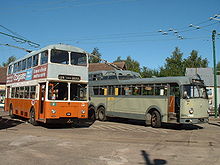Gebr. Ludewig


The company Gebr. Ludewig operated a body factory in Essen . It made a name for itself above all as a manufacturer of omnibuses including trolleybuses and in particular of one and a half decker buses .
Company history
Until 1945
The company began in 1909 in Essen under the company "Kopp & Ludewig" to manufacture bodies for cars and station wagons . The location on Steeler Strasse had existed since 1919. The name of the company changed to “Gebr. Ludewig GmbH ". In the 1920s, Bugatti was given a factory agency . From 1934 bodies were on buses mainly on chassis of Opel produced. Military buses followed during the war.
After the Second World War
After the war, a cooperation with Büssing began to manufacture buses . A specialty of the Ludewig brothers from 1949 was the development of one and a half-decker buses. They had a lowered stern area and a second deck above. So the seat volume could be increased with hardly any longer vehicle length. Because of the increased vehicle weight, the buses were equipped with an additional trailing axle at the rear . In the large cities of North Rhine-Westphalia in particular , the one and a half-decker buses were popular for long journeys, e.g. B. to connect neighboring cities. 22 trolleybuses were also built as one-and-a-half-deckers by the Ludewig brothers. In the coach sector was seen Anderthalbdecker rare, although in 1960 the operation of bus trailers were forbidden. In passenger traffic, the seats in the lower deck area were not readily accepted by passengers; In regular service, early models had the low-floor access platform in this area and the conductor's seat next to it . This construction method enabled passengers to board quickly on scheduled services. After the introduction of one-man operation, the direction of the passenger flow changed so that the entry was now at the front of the driver. The previous advantage was lost.
Due to the success in building one and a half deckers in the bus business, Ludewig neglected the touring coach market. From the 1960s onwards, articulated buses increasingly appeared, which also have a larger passenger volume. These buses were initially made by other body manufacturers such as Gaubschat in Berlin , Göppel in Augsburg and Vetter in Fellbach . From 1968 Ludewig also manufactured articulated buses on chassis from Daimler-Benz and Büssing. Later, buses were increasingly manufactured entirely by the dominant commercial vehicle manufacturers Daimler-Benz and MAN . The Ludewig company therefore had to give up bus production in 1976. The Vetter company continued to manufacture one-and-a-half-decker buses until 1983.
The original company on Steeler Strasse in Essen last traded as Gebr. Ludewig GmbH & Co. KG , it had specialized in the repair of buses and the manufacture of special bodies. At the end of January 2015, it became known that the company had filed for bankruptcy. At first, operations continued. The factory facilities were demolished in November 2018.
literature
- Wolfgang H. Gebhardt: German travel buses . Motorbuch-Verlag, Stuttgart 2009, ISBN 978-3-613-03037-4 . Pp. 139/140
Individual evidence
- ↑ Ludewig insolvent - employee relieved , derwesten.de from January 24, 2015, accessed on January 26, 2015